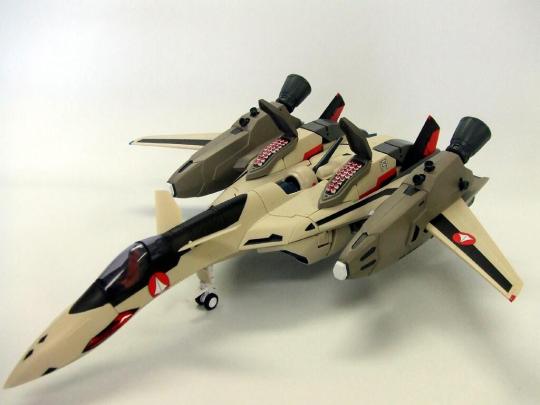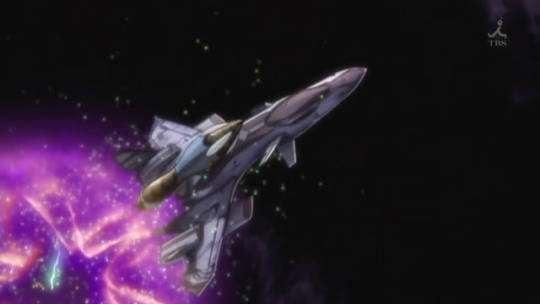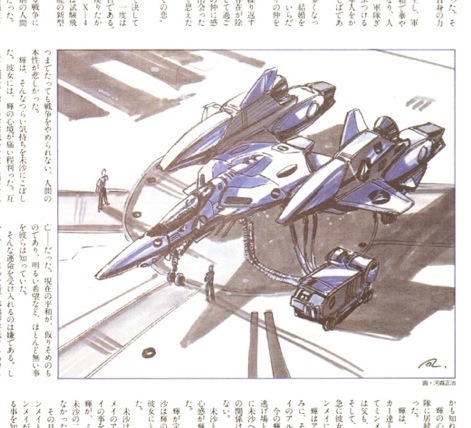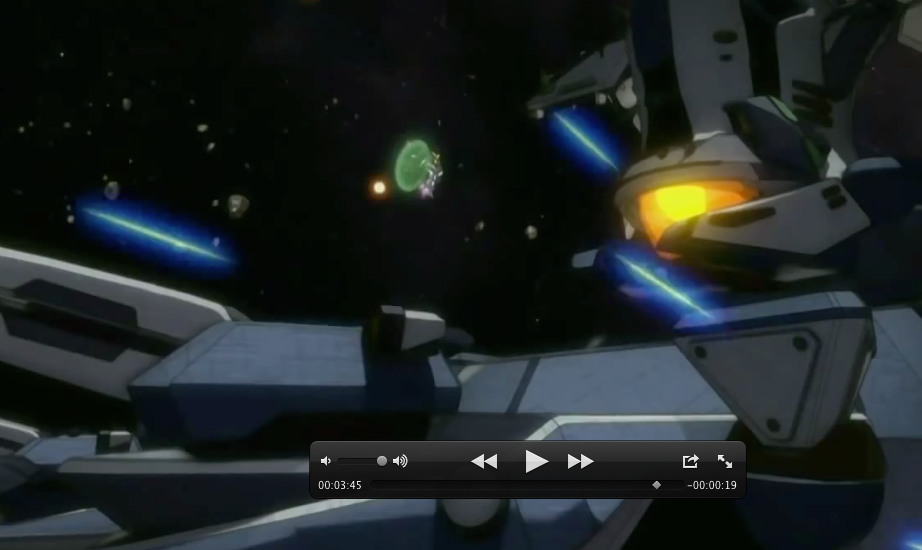-
Posts
153 -
Joined
-
Last visited
Content Type
Profiles
Forums
Events
Gallery
Posts posted by Andras
-
-
I tried to count the YF-22s missile load in Plus. I got about 80 missiles evenly split between internal launchers and FAST packs.
-
I wrote up those messed up HWRs (for Mekton) as reconstruction era refits that used all energy weapons to simply supply. The 4 back guns were the Tomahawk's Electron Beam cannon, and the arms have VF-4 beam cannon.
-
What happened to the Monsters that were badly animated in SDFM Ep32? The back guns have a wide separation in the middle, and they almost look like each pair of guns (left & right) are stacked vertically.
Was it another outsourced episode?
-
I always figured the hull in DYRL is simply a SDFN production series hull standing in for the SDF1 which is still sitting in the middle of Macross City. They weren't going to rip the original hull out of the middle of the city just to film a movie.
-
Just curious but what's the source for the 12 missiles in each leg for the Advance packs?
-
Aren't there 46 more missiles in the shoulder packs.

-
One of my favorite tracks from the old Bubblegum Crisis anime was lifted from a French song.
Mysterious Night
https://www.youtube.com/watch?v=X1kLb-T2UMk
Jeanne Mas- Johnny Johnny
-
Driver and Grey you are correct. Nothing beats a dedicated ground attack aircraft but a lot of fighters that have excelled in the multirole arena were never intended as multirole. The F-4 was designed as a fleet defense fighter but as always with the continuing development engineers and the military would ask the question "hey would it be plausible to drop a MK-82's for use against ground targets".
That's not entirely correct. The F-4 started as the AH-1 attack airplane concept and it never lost that ability when redesigned for fleet intercept. The first Marine F-4 squadrons were All Weather VMFA fighter/attack squadrons. Ground attack capability isn't something that was back-fitted to the F-4, it was something it never lost in the first place.
The P-47 was a high-altitude fighter that eventually became the premier fighter-bomber and ground-attack plane for the US Army in WWII and proved exceptional in both roles.
-
The nose gear is offset correctly to be an A-10 seen from the rear.
-
Has there been any more information about this spaceplane published?

(image from page 1, Frontier Tech thread vol III, originally posted by redwolf, rehosted to tumblr to save his bandwidth)
-
Is this the extended magazine you're talking about? (lower left)

Also from Perfect Memory, what is going on here?
Prototype VF4 with FAST boosters?
That's clearly a VF-1 forward fuselage.

-
There is this:


Which is actually two overlapping discs.
-
Plus the chemical thrusters are more powerful then the fusion turbines going back to the Vf-1 Super packs, ~10x more powerful then the stock FF2001 w/o overboost.
Even the VF-25s Super boosters are ~twice as powerful as the installed fusion turbines.
-
Is there a rational explanation for Q-Raus to be destroying frigates and Guantanamo carriers with their tri-lasers and micromissiles?
2:45-2:55 for ref
https://www.youtube.com/watch?feature=player_detailpage&v=0C0jy0AWi_s#t=160
-
link to answer? I 'd like to read it.
-
-
It's not intuitive, but it's how it works. Basically, go play Asteroids for an hour or two, and you'll have a much better feel for it. And it's the most fun you can have while studying physics.

Or Kerbal Space Program.
-
That's the direction I was leaning, and it's possible to do that in Mekton anyway.
-
I have a question about the Tomahawk's main guns in the arms.
I'm mostly familiar with the depiction In DRYL, they were depicted as single fire heavy guns.
I've been watching a dubbed SDFM for the first time, and the Tomahawk arm guns seem to be burst firing guns, or at least, with a very rapid firing rate. See the Mars episode, right after the order to fall back, for one example. It seems to fire 4 bursts of three shots in rapid succession.
Is there a reason for the difference? If the depiction in DYRL is accurate is there a possibility of a second generation of Tomahawk with heavy arm guns instead of the burst guns?
-
Do you know if there is any specific designation for those -11C pods?
Thanks again.
-
I asked about missile pods for the VF-19 in the other thread, here's a VF-19 model with the VF-11 single pods under wing. I see "MML" in the last caption, are they saying those are missile pods?
http://wind.ap.teacup.com/eminence/1549.html
-
Your math's off in a few areas... the GU-11's muzzle velocity is 2km/s, not 3.3. Also, the VF-1's head laser is delivering 100 5MW discharges per second, per spec.
A megawatt is a megawatt. If it's divided up into 100 pulses, it's still only 5MW. A 5MW pulse 1/100th of a second long is 50kj. Actually it would have to be less since there is dwell time between the pulses, otherwise it's a CW laser, not pulsed. 50% duty time gives 25kj pulses.
VFMF=unofficial, but even at 2km/sec, that's ~4-5MJ/shell=80MW+
(2.4kg shell scaled from the Avengers 30mm ammo=4.8MJ/hit)
-
Generic super-tough awesome-armor is cancelled out by the generic super-awesome weapons.
3km+/sec gunpods, missiles w warheads 10x as powerful as TNT, 5MW head lasers, etc.
a 2kg shell at 3.3km/s is nearly 11MJ each (more then 2x a 120mm APFSDS round), at 1200rpm, thats 217MW for the GU-11.
A VF-1 quad headlaser is less then a 1/10th that.
Since Hikaru crashed through a bridge in DYRL in G mode, and he went into the buildings in SDFM in G mode at first, how does B mode demonstrate more toughness then that? A wrecked Zentraedi fell through a building before blowing up. In all modes they are equally vulnerable to enemy weapons. In SDFM did the Battlepods have to work 10x as hard to blow up the VF1s in the city compared to in the air?
We all agree that the VFs are tougher then normal airplanes, but that was also initially racked up to Overtech materials, not ECA in B mode. If they had said- ECA runs all the time off waste energy from the fusion plant to enhance the armor protection offered by OTM- that would be frakking dandy. It's invisible, it works all the time, no problems. But when they say it's only in B mode and it makes the VF 10x tougher in B mode, and THAT is not demonstrated in the show, except, what, once? With a main character using a special VF? It's a far reaching ret-con that causes more issues then it solves.
-
The problem I have with ECA is that while it's a lot of techy sounding words written down, is it ever shown on the screen as being effective? PPBs are actually shown to work many times.
Where does the extra power come from in B mode that isn't there in F mode? If the fusion turbines/thrusters are working harder in F mode, they should be making more power, not less. If the VF-0 had ECA powered off regular turbofans, what is the hold up on fusion turbines? They should be able to power it with a trickle charge compared to the power available to the VF-0*. The VF-1 has 1.3GW in it's fusion engines, 1% of that is more then the total power available to a conventional turbofan fighter.
If ECA was effective in B mode, why do the VFs typically remain in F mode once they enter combat? (Aces tend to go to Bmode) They should be able to laugh off hits that would destroy them in F mode, and the cockpit is more protected.
To be fair to M:7, they actually did that, and it didn't help the cannonfodder VF11s at all while Max blew up the Varuta VFs in B mode with single micromissiles.
Cannon fodder is cannon fodder and Aces are hardly ever hit. ECA doesn't protect Cannon fodder and Aces don't need it.
About the only time I've heard of "ECA" working as designed is the Vajra, and they are space bugs with space bug magic anyway.
*Compendium:
Two EGF-127 custom overtuned conventional turbofan jet engines with two-dimensional thrust-vectoring nozzles, each rated at 91.08 kN and 148.9 kN with afterburning. (Future variable fighters will incorporate thermonuclear reaction engines that are under development.) Due to its less efficient engines, the VF-0 has considerably shorter range, more delicate handling, and longer airframe compared to the VF-1. (Engine nacelles are comparatively longer to accommodate the earlier engine design.) Rectangular underfuselage air intake with semi-retractable slit-style shutter in Battroid mode or space use.
No fusion power there.
Due to AWAG/RA 105 SWAG energy converting armor which uses Overtechnology, the VF-0 can employ surplus power to triple the Fighter mode's armor strength in Battroid mode. (Future variable fighters will incorporate similar technology.) Majority of engine output is dedicated to flight so energy conversion armor is not functional during Fighter-mode. In GERWALK, energy is diverted to energy conversion armor for a defensive power-equivalent to an attack helicopter. Although the strength in GERWALK-mode is 4~5 times greater than in fighter mode, it is still inferior compared to Battroid mode which is 10 times greater compared fighter mode.
In B mode, the turbines are the only thing holding up the VF0, in F mode, wing and body lift 'holds it up' in the air. The turbines should be working harder in B mode then in F mode, just like an AV-8B Harrier in VTOL mode. In G mode it still gets some wing lift but it's still mostly the turbines providing direct lift at low speeds.
In space of course, there should be no difference at all between the power used for movement between F mode or B mode by the rest of the VF fleet.


The Newbie and Short Questions thread
in Movies and TV Series
Posted
Well, in the series, the VF-1 Super had a dozen micros in each armpod (it fires 6 pairs from each arm) and a further (minimum) 16 in each booster pod. So more like 5 dozen.